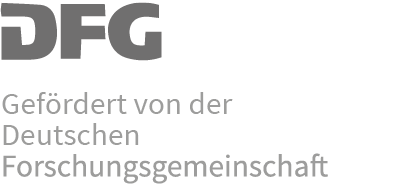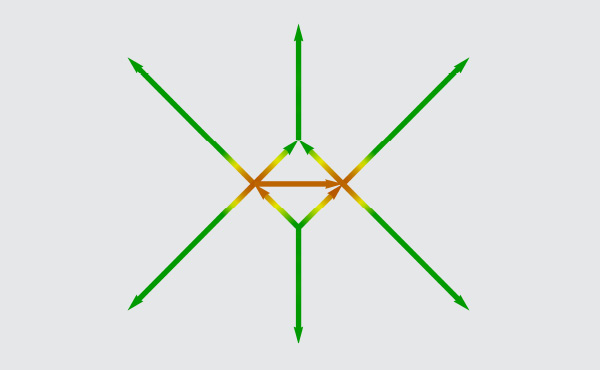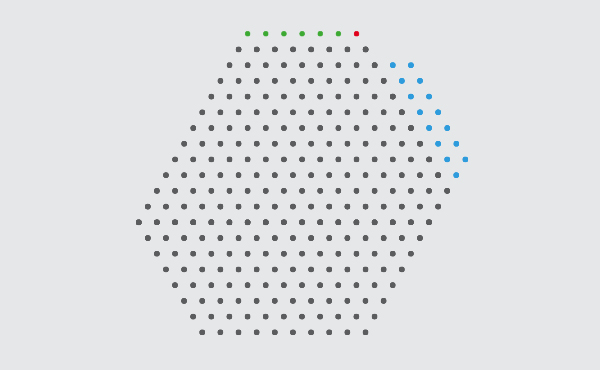Projects in Funding Period 2012 - 2016
Projects of the SFB Transregio 109 in Funding Period 2012 - 2016
A01: Discrete Riemann Surfaces (continued)
- Investigating the Facets of Discrete Complex Analysis
- Principal Investigators: Alexander Bobenko, Ulrike Bücking, Boris Springborn
- Investigators: Niklas Affolter, Nikolay Dimitrov, Felix Knöppel, Hana Kouřimská, Isabella Retter, Stefan Sechelmann, Lara Skuppin
-
Riemann surfaces arise in complex analysis as the natural domain of holomorphic functions. They are oriented two-dimensional real manifolds with a conformal structure. Several discretizations of Riemann surfaces exist, e.g., involving discretized Cauchy-Riemann equations, patterns of circles, or discrete conformal equivalence of triangle meshes. Project A01 aims at developing a comprehensive theory including discrete versions of theorems such as uniformization, convergence issues and connections to mathematical physics.
A02: Discrete Constant Mean Curvature Surfaces (continued as A02: Discrete Parametrized Surfaces)
- Developing a Theory of Discrete Surfaces with Constant Mean Curvature
- Principal Investigators: Tim Hoffmann, Alexander Bobenko
- Investigators: Benno König, Jan Techter, Zi Ye
-
In recent years, an exhaustive theory has been developed to understand and construct discrete minimal surfaces. We aim to produce something similar for the construction and classification of discrete surfaces with constant mean curvature (cmc). In particular, for discrete minimal surfaces the study of Koebe polyhedra that serve as Gauß maps has been fruitful - we are interested in analoga for discrete surfaces with constant mean curvature.
A03: Geometric Constraints for Polytopes (continued)
- Exploring the Subtle Interplay of Geometry and Combinatorics
- Principal Investigators: Günter Ziegler, Raman Sanyal, Carsten Lange
- Investigators: Philip Brinkmann, Moritz Firsching, Tobias Friedl, Lauri Loiskekoski, Hannah Schäfer Sjöberg
-
Polytopes are solid bodies bounded by flat facets. Alternatively, they can be described as the convex hull of their vertices. Thus a polytope can be presented by information on two aspects, a geometric one: "What are the coordinates of the vertices" and a combinatorial one: "Which vertex is incident to which face". There are many interrelations between these two levels: Combinatorial requirements enforce restrictions on the geometry, and vice versa. A03 studies aspects of this interplay.
A04: Integrating Discrete Geometries and Finite Element Spaces (completed)
- Building Bridges Between Discretization in Computational Geometry and in Finite Element Analysis
- Principal Investigators: Folkmar Bornemann, Konrad Polthier
- Investigators: Anna Wawrzinek
-
Finite element methods are in every day use in engineering and modelling. The main idea with finite elements is to discretize objects such as machine parts or architectural elements in order to then simulate the movement and behaviour of these objects via discrete computations. Project A04 aims to link experiences from those applications of scientific computing with ideas from discrete geometry to improve the integration of technologies.
A05: Conformal Deformations of Discrete Surfaces (continued)
- The Construction of a Discrete Differential Geometry Version of Certain Conformal Deformations
- Principal Investigators: Ulrich Pinkall
- Investigators: David Chubelaschwili, Wai Yeung Lam
-
Two geometries can be considered equivalent if there exists an angle preserving transformation between them; this is a so called conformal transformation. In the smooth case, conformal equivalences are quite well understood. However, mimicking their construction in the discrete case brought up not only interesting properties and algorithms, but also interesting problems - first and foremost the question of how to construct conformal deformations with certain prescribed properties.
A07: Discrete Morse Theory (completed)
- Finding Global Topological Information from Local Properties in a Discrete World
- Principal Investigators: Günter Rote
- Investigators: Dror Atariah, Bruno Benedetti
-
The idea behind Morse theory is to derive global topological information about objects which are locally investigated by means of differential geometry. Although originally coming from the smooth world, Morse theory has also been adapted several years ago to discrete objects, for instance to triangulations. But there are many open questions, particularly concerning those vertices in the nets that are critical for the underlying topology.
A08: Discrete Geometric Structures Motivated by Applications in Architecture (continued as C01: Discrete Geometric Structures Motivated by Applications and Architecture)
- Geometry Supporting the Realization of Freeform Architecture
- Principal Investigators: Alexander Bobenko, Helmut Pottmann
- Investigators: Thilo Rörig
-
Many of today's most striking buildings are nontraditional freeform shapes. Their fabrication is a big challenge, but also a rich source of research topics in geometry. Project A08 addresses key questions such as: "How can we most efficiently represent and explore the variety of manufacturable designs?" or "Can we do this even under structural constraints such as force equilibrium?" Answers to these questions are expected to support the development of next generation modelling tools which combine shape design with key aspects of function and fabrication.
A09: Semidiscrete Surfaces (continued as C01: Discrete Geometric Structures Motivated by Applications and Architecture)
- Geometry Between the Discrete and the Continuous
- Principal Investigators: Johannes Wallner
- Investigators: Wolfgang Carl
-
Semidiscrete surfaces are mappings of both continuous and discrete variables, representing the intermediate points in a spectrum of mappings spanned by the extremal cases of purely discrete and purely smooth surfaces. Our research in this area is motivated by applications, in particular the approximation of smooth surfaces by piecewise-developable ones. A great deal of their attraction of semidiscrete objects lies in the fact that they can lead us to a deeper understanding of both the discrete and continuous cases.
A10: Riemannian Manifold Learning via Shearlet Approximation (continued as C03: Shearlet approximation of brittle fracture evolutions)
- Analyzing Geometry by Applied Harmonic Analysis Methodologies
- Principal Investigators: Gitta Kutyniok
- Investigators: Jackie Ma, Philipp Petersen
-
Applied harmonic analysis provides powerful methodologies to approximate geometric objects, which might be given as a Riemannian manifold itself or as an approximating point cloud. The main tools are specifically designed representation systems such as shearlets. These systems are of a multiscale type, thus an approximation process provides different resolution levels. One might ask: "Which resolution level allows detection of which geometric properties, such as curvature or torsion?" Project A10 aims to analyze such relations between approximations and learning of geometrical properties.
B01: Complexification of Discrete Time (completed)
- How Complex Time Helps to Make Algorithms and Simulations More Stable
- Principal Investigators: Jürgen Richter-Gebert
- Investigators: Stefan Kranich, Katharina Schaar
-
Time may not always be considered to be a linear flow. If a time dependent problem is regular enough one may replace a one-dimensional (real) time variable by a two-dimensional (complex) time variable. By this it suddenly becomes possible to bypass critical singular or nearly-singular situations and to broaden the practical applicability of simulations. The research goal of B01 is to exploit these detours in time for problems in dynamic geometry and elementary particle mechanics.
B02: Discrete Multidimensional Integrable Systems (continued)
- Classifying and Structuring Multidimensional Discrete Integrable Systems
- Principal Investigators: Alexander Bobenko
-
In recent years, there has been great interest among differential geometers for discovered discrete integrable systems, since many discrete systems with important applications turned out to be integrable. However, there is still no exhaustive classification of these systems, in particular concerning their geometric and combinatoric structure. This is the goal of B02.
B03: Numerics of Riemann-Hilbert Problems (continued as B03: Numerics of Riemann-Hilbert Problems and Operator Determinants)
- The Search for the Optimal Contour
- Principal Investigators: Folkmar Bornemann
- Investigators: Georg Wechslberger
-
Riemann-Hilbert Problems (RHP) are another way of expressing equations satisfying a special property and have some advantages over the traditional forms. Take for example an equation describing the motion of a water wave and its current state: Both the traditional form and the RHP form of the equation enables us to calculate the state of the wave at any point in time. But with the RHP form we can accomplish this without knowing or calculating anything about the state of the wave in between.
B04: Discretization as Perturbation: Qualitative and Quantitative Aspects (completed)
- Impact of Discretization for Integrable Hamiltonian and Nonholonomic Dynamics
- Principal Investigators: Jürgen Scheurle, Yuri Suris
- Investigators: Fernando Jiménez Alburquerque, Mats Vermeeren
-
Continuous time dynamical systems have to be discretized in order to find solutions numerically using a computer. This generally leads to a perturbation of the original dynamical behaviour. In particular, the long-term evolution might change drastically, e.g., regular behavior may turn into chaotic behavior. This raises the question of how to control the corresponding discrepancies. The research goal of B4 is to study this question for integrable and nonholonomic systems, both from quantitative and qualitative perspectives, exploiting the detour of embedding discrete dynamics into the dynamics of a non-autonomously perturbed continuous time system.
B06: Potential Energy Surfaces (completed)
- Discretizing the Forces for Molecular Quantum Dynamics
- Investigators: Johannes Keller, Caroline Lasser, Giulio Trigila, Stephanie Troppmann
-
Potential energy surfaces are at the origin of the analytic description of molecular quantum dynamics and they give insight in it. B06 explores the accessibility of these high-dimensional structures for simulations of chemical processes which are fundamental for our understanding of basic principles in nature.
B07: Lagrangian Multiform Structure and Multisymplectic Discrete Systems (continued as B02: Discrete Multidimensional Integrable Systems)
- Investigating integrability of variational systems
- Principal Investigators: Yuri Suris, Matteo Petrera
- Investigators: Raphael Boll
-
Integrability is a remarkable property shared by some dynamical systems. Its understanding allows to study more complicated non-integrable systems by means of perturbative techniques. Integrability is, on the one hand, a beautiful mathematical laboratory, on the other hand, a rigid constraint. Such rigidity is reflected in the existence of some characterizing geometric features of the space where integrable systems live. The project B07 is devoted to the study of discrete integrable systems of variational origin, namely coming from variational principles.
B08: Crystallization, Defects, and Lattice Elasticity (continued as B08: Wigner crystallization)
- Understanding Crystallization
- Principal Investigators: Marco Cicalese, Gero Friesecke
- Investigators: Rufat Badal, Lucia De Luca, Dominik Jüstel, Franscesco Solombrino
-
Many basic phenomena in solid mechanics like dislocations or plastic and elastic deformation are in fact discrete operations: small breakdowns of perfect crystalline order. The goal of this project is thereofore to address the phenomenon of crystallization, and its breakdowns, from the point of view of energy minimization.
B09: Discrete Gradient Flow in Mass Transportation Metrics (continued as B09: Structure Preserving Discretization of Gradient Flows)
- Analyzing Discrete Curves of Steepest Descent in Discrete Energy Landscapes
- Principal Investigators: Oliver Junge, Daniel Matthes
- Investigators: Daniel Karrasch, Horst Osberger, Simon Plazotta, Jonathan Zinsl
-
Many evolution equations from physics, like those for diffusion of dissolved substances or for phase separation in alloys, describe processes in which a system tries to reach the minimum of its energy (or the like) as quickly as possible. The descent towards the minimum is restrained by the system’s inertia. In this project, we discretize these evolution equations by optimizing discrete curves in a discrete energy landscape with respect to a discrete inertia tensor.
C: Interactive Tools for Research and Demonstration (completed)
- Bringing Discretization to Light
- Principal Investigators: Tim Hoffmann, Jürgen Richter-Gebert, Ulrich Pinkall, John M. Sullivan
- Investigators: André Heydt, Michael Strobel, Martin von Gagern
-
Today, software for analyzing and visualizing mathematical objects is an important tool for getting a grip on the mathematical matter one is exploring. There is already a lot of expertise in the SFB/Transregio with software in different fields of differential and combinatorial geometry. Project C01 aims to bring this experience together, for instance by building generic libraries for visualization and 3D-rendering or by enhancing the interoperability of the existing software projects.
CaP: Communication and Presentation (continued)
- Research on Transporting Maths Content from the SFB to the Public
- Principal Investigators: Jürgen Richter-Gebert, Günter Ziegler
- Investigators: Carsten Lange
-
Images from geometry can serve as a visual pathway into mathematics. In the SFB they are leading in particular into pioneer research. This is to be taken as an opportunity: We would like to learn more about how mathematics can be communicated by means of visual content. And we would like to communicate new results from the SFB.
Z: Central Project (continued as Z: Central Tasks)
- Principal Investigators: Michael Joswig, Massimo Fornasier, Myfanwy Evans, Felix Krahmer, Ulrich Bauer, Herbert Edelsbrunner
- Investigators: Leonardo Alese, Ekaterina Eremenko, Markus Hansen, Olga Holtz, Martin Kilian, Sara Krause-Solberg, Andreas Loos, Frank H. Lutz, Aaron Montag, Konstantin Poelke, Michael Sandbichler, Martin Skrodzki
-





















